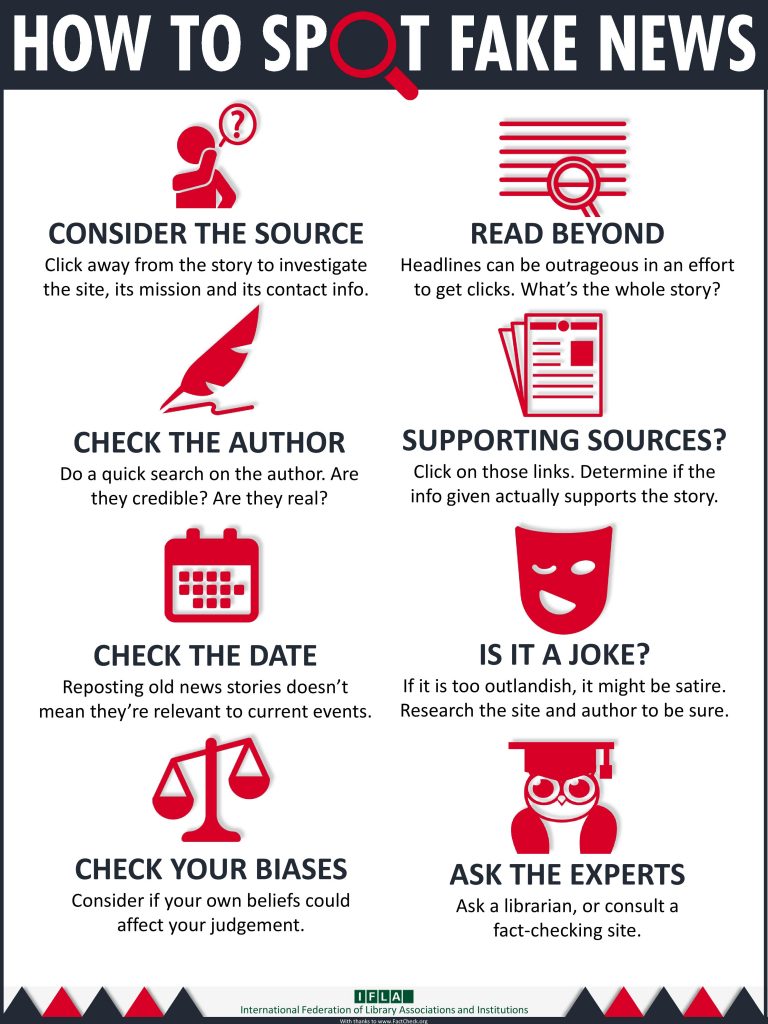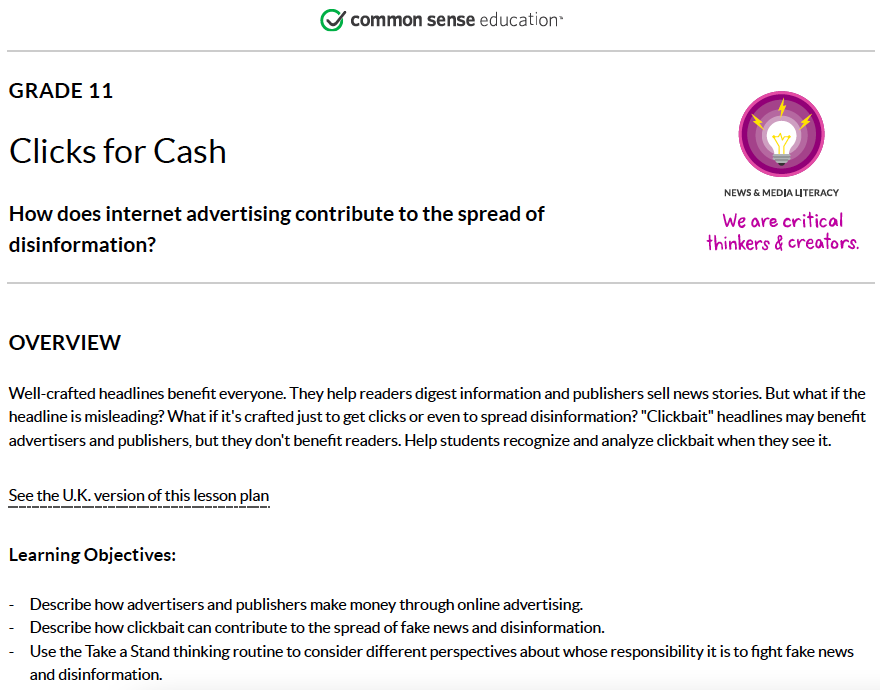To continue the conversation surrounding digital citizenship, increasing our students’ digital literacy is one of the ways we can ensure they are reading accurate information. Furthermore, they are completing projects, scrolling social media, and spreading information confidently and competently, especially knowing that the information is accurate.
Fake news is all around us. For the most part, people see something with an eye-catching headline. This leads to being blinded by the title and, therefore, ignoring the important information that tells a person its accuracy. I can attest to this “blinding” because, even though I have the information to tell whether something is correct or accurate, I can still read things and be “pulled in” and ignore that knowledge.
Are you a victim of being blinded by a headline of #fakenews?
Ways of Finding #fakenews
I watched a YouTube video by John Spencer on the five C’s of critical consumption. John says it is easier than ever to not only share and spread misinformation. He also said that 25% of students could distinguish between fake and real news. Here are the five C’s that is used in the video:
Five C’s:
- Context – When was it written? Where does it come from?
- Credibility – Does the author cite credible sources? Does the cite have a reputation?
- Construction – What is the bias? Are there any loaded words?
- Corroboration – Is this the only source that’s making this claim?
- Compare – Compare to other cites and information
This is a great video to use as an introduction to the information or lesson on digital literacy. John concluded with a great statement, “When we teach students media literacy and they learn how to consume critically, they learn how to think critically.” This is so important to create a critically thinking citizen of today’s world of spreading information.
Here are some similar resources for your students:

Other Sources:
Podcast by KQED about innovative ways to enhance students’ learning
Searches your article(s) via URL on Snopes.com
Dangers of #fakenews:
So what exactly is fake news? Kevin Swayze’s article says, “Fake news is a catch-all description of what some people have called weaponized lies. Three general categories:
- Misinformation, defective information or mistakes
- Disinformation, such as hoaxes,
- Malinformation and stories intended to damage institutions and individuals.” (Jan 2021)
Donald Trump had coined the term “fake news” during his presidency and electoral events. Unfortunately, Trump supporters buy into all of his “fake” contributions to his Twitter. This ultimately led to Trump being banned from Twitter. He was sharing, sensitive misleading information that could have led to some serious events.
Humans have an instinctive desire to be in a group; a desire to belong. We’re wired to react emotionally, not rationally. We find comfort in similarity and alert to things out of the ordinary.
Swayze, K. (January 2021)
All three of the categories mentioned above are widely used in social media and can attract any age group by using things like “clickbait” to bring in people to this fake news. The Tilt blog spoke more about the misinformation and clickbait that exists.
Part of the problem with trying to find accurate news on social media is that we are often trapped in a filter bubble of information – meaning that we only read, like, and share things that align with our own belief system.
— Lindsay Matts-Benson
This quote stuck with me while I read this blog post (linked above). It is true that the internet, your phone, your google history, etc. are listening to what you are doing and aligning things for you. This is an example of the algorithm of the internet. That means you will be likely to look at the same point of view wherever you are on the internet. The blog post suggested that we challenge the internet’s algorithm and find things in another view to ensure a well-rounded bringing of suggestive information.
The fact of the matter is: you must think of all information as fitting under the three categories above and then prove it otherwise. This way, you get to decide, with your knowledge of seeking accurate information out, whether something has merit or not.
To conclude, misinformation is so important, especially in times like this: a pandemic. There is a lot of misleading information surrounding the symptoms, signs, causes, and spread of the COVID-19 virus. Personally, I have had many conversations with people who have shared misinformation with me about COVID-19. The most popular one right now: I have the COVID vaccine, I can’t spread COVID to others now. This is 100% false.
In most situations, students and their parents are spending a lot of time on their social media accounts scanning for information on things like this. Even if they are not looking for it, it usually pops up because it is trending. It is important to teach students at a young age to understand credible information and how it impacts the way that you share information with others.
Teaching to High School Students
Like in my last blog post, it is a very simple addition to any lesson or assessment in a classroom. For example, in Health 9 or Wellness 10, we usually use action plans when teaching any topic covered in either course. In my classroom, these action plans have students look into resources they could use to complete the action plans. A more specific example: in health 9, I have students assess food guides in every country and look up any health promotion strategies a country has to improve the health of its residents. I always stress the importance of looking for cites that end in .org or .edu to ensure it is credible information but I do have them use the CRAAP test on them as well. Below is a screenshot of a well-versed lesson plan from Common Sense Education. It would very likely be something I would use to deliver information on digital literacy. Download the PDF below:

Incorporating the NCTE Framework
The National Council of Teachers of English (NCTE) supports teachers and their students in classrooms and other environments. They also share lesson ideas, research, and teaching strategies. They work to improve the teaching and learning of English and Language Arts at all levels fo education (NCTE, 2017).
First of all, I have never taught English on my own and I hope that I get lucky enough to never have to. I love and respect those who have the passion for teaching English but, unfortunately, my interests lie elsewhere. Although I do not have the scope of English in mind, I will take the passenger seat with digital literacy and help in any way that I can. It is important to have a collaborative view on digital citizenship and its sub-categories.
In my classroom(s), I will use the NCTE to give students opportunities to continue their learning with the knowledge they have with the new information to ensure improved confidence. This means finding a baseline for each student through activities that prompt this knowledge. As they learn, it is important to challenge their thinking by providing them many opportunities to use this knowledge. This can be done by using a variety of educational technology and tools that are applicable. More importantly, making sure that I do my job as a teacher: to provide accurate and up-to-date information.
How would you incorporate this into your subjects that are different from my method?




